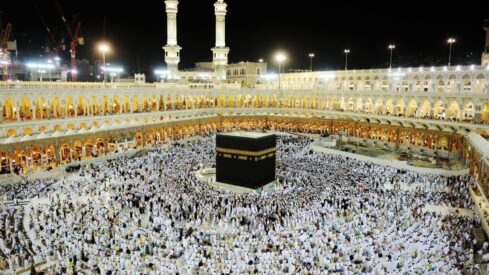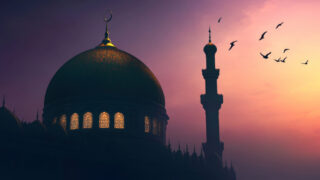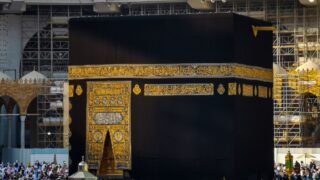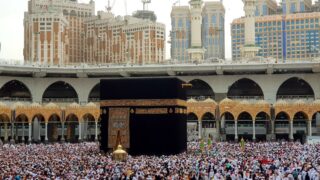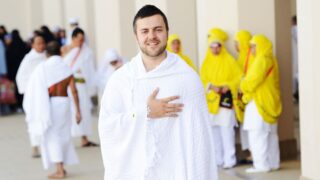When does Hajj start and end? With the approach of one of the most important seasons in Islam, many Muslims around the world are eager to know when Hajj begins and ends. Hajj is one of the pillars of Islam and must be performed at least once in a lifetime by all adult Muslims who are physically and financially able to undertake the journey.
Before we answer when Hajj begins and ends, we should note that Hajj is one of the most significant Islamic rituals. It gathers many Muslims from various parts of the world, united in worship, remembrance, and supplication. During Hajj, Muslims practice patience, humility, forgiveness, and sincerity in their work and obedience to God.
Hajj offers a multifaceted experience for pilgrims, teaching them patience, endurance, sacrifice, humility, sincerity, and forgiveness. Pilgrims return from Hajj filled with energy, satisfaction, and faith, motivated to apply what they have learned in their daily lives. Therefore, many people ask when Hajj begins and ends.
What is Hajj?
Before knowing when Hajj begins and ends, we should understand that Hajj is the fifth pillar of Islam. God has made it obligatory for every Muslim, male and female, once in their lifetime, provided they are able, which means having the provision and means for the journey. Additionally, for women, a mahram (a male guardian) or a trustworthy group is required.
- Linguistically: Hajj means to set out or to intend a significant place. It is said, “Someone came to us,” meaning he arrived, and “He performed Hajj,” meaning he intended. A person who is intended is called “mahjooj.”
- Terminologically: Hajj means to set out for a specific place, namely the Sacred House (Kaaba) and Arafat, at a specific time, which is the months of Hajj, to perform specific acts such as standing at Arafat, circumambulating the Kaaba, and running between Safa and Marwa, according to the majority of jurists, with specific conditions.
- Legally: Hajj is defined as “a specific intention to a specific place at a specific time with specific conditions,” as stated by the scholar Al-Dardir: “Standing at Arafat on the night of the tenth of Dhu al-Hijjah, circumambulating the Kaaba seven times, and running between Safa and Marwa likewise in a specific manner with Ihram.
The jurists agree that Hajj is an individual obligation for every able Muslim once in their lifetime. Its obligation is established by the Quran, Sunnah, and consensus.
- From the Quran, Allah says: “And Hajj to the House is a duty that mankind owes to Allah, for those who can find a way there. But if anyone disbelieves, then Allah stands not in need of any of the worlds.” (Quran 3:97). This verse explicitly establishes the obligation of Hajj, as the phrase “owes to Allah” signifies obligation. The confirmation is in “But if anyone disbelieves,” implying that neglecting Hajj is akin to disbelief, not typical of a Muslim but rather of a non-believer.
- From the Sunnah, numerous hadiths affirm this obligation. Ibn Umar narrated that the Prophet Muhammad (ﷺ) said: “Islam is built upon five: the testimony that there is no deity but Allah and that Muhammad is the Messenger of Allah, establishing prayer, giving zakat, fasting Ramadan, and performing Hajj to the House.” (Bukhari). The indication is clear that Hajj is a fundamental pillar of Islam.
- Consensus: The entire Muslim Ummah agrees on the obligation of Hajj once in a lifetime for those who are able. It is among the known obligations of the religion, and denying it is considered disbelief. Hence, the question of when Hajj begins and ends is repeatedly asked each year.
Hajj in Islam is the pilgrimage to the city of Mecca at a specific time each year, with specific rituals known as the rites of Hajj. It is obligatory once in a lifetime for every capable adult Muslim. The question of when Hajj begins and ends is important because it is a fundamental pillar of Islam, as the Prophet Muhammad (ﷺ) said: “Islam is built upon five: the testimony that there is no deity but Allah and that Muhammad is the Messenger of Allah, establishing prayer, giving zakat, fasting Ramadan, and performing Hajj to the House for those who can find a way there.” Hajj is an individual obligation for every capable adult Muslim, as mentioned in the Quran: “And proclaim to the people the Hajj; they will come to you on foot and on every lean camel; they will come from every distant pass.” (Quran 22:27).
Numerous hadiths highlight the virtue of Hajj, such as the Prophet Muhammad (ﷺ) saying: “The best deeds are belief in Allah and His Messenger, then jihad in the way of Allah, then Hajj Mabrur.” He also said: “Whoever performs Hajj and does not have sexual relations nor commit sin, will return as free from sins as the day he was born.” And: “The reward for Hajj Mabrur is nothing but Paradise.”
When Does Hajj start and End?
The rituals of Hajj generally start on the eighth day of Dhu al-Hijjah when pilgrims enter into Ihram from designated Miqats, then proceed to Mecca for the Tawaf of arrival, followed by traveling to Mina to spend the Day of Tarwiyah, then moving to Arafat for the Day of Arafat. Afterward, pilgrims throw pebbles at the Jamarat in the Jamarat al-Aqaba, return to Mecca for the Tawaf of Ifadah, and spend the Days of Tashreeq in Mina, finally returning to Mecca for the Farewell Tawaf before leaving the holy sites.
6 Virtues of Hajj
In addition to knowing when Hajj starts and ends, it’s important to understand the numerous virtues of Hajj. Dr. Jamal Al-Maraki mentioned six virtues in his article titled “The Virtues and Benefits of Hajj”:
1. One of the Best Deeds and Acts of Worship:
– Hajj is considered one of the best deeds in Islam. Abu Huraira (RA) reported that the Messenger of Allah (PBUH) was asked, “What is the best deed?” He said, “Faith in Allah and His Messenger.” He was asked, “Then what?” He said, “Jihad in the way of Allah.” He was asked, “Then what?” He said, “A Hajj Mabroor (accepted Hajj).” (Reported by Bukhari, Muslim, Tirmidhi, Nasa’i, and Ahmad).
2. Hajj Equals Jihad for Those Who Cannot Perform It:
– Hajj is considered equivalent to Jihad for those who are unable to participate in Jihad. Aisha (RA) reported that she said, “O Messenger of Allah, we see Jihad as the best deed, should we not engage in Jihad?” He said, “No, the best Jihad for you is a Hajj Mabroor.” (Reported by Bukhari in the Book of Hajj, Hadith 1423).
In another narration, she said, “O Messenger of Allah, should we not go out and fight in Jihad with you? He said, “The best and most beautiful Jihad is a Hajj Mabroor.” Aisha said, “I will never stop performing Hajj after hearing this from the Messenger of Allah.” (Bukhari, Book of Hajj, Hadith 1728).
In a narration by Nasa’i, she said, “O Messenger of Allah, should we not go out and fight in Jihad with you, for I do not see any deed in the Quran better than Jihad.” He said, “No, the best and most beautiful Jihad is Hajj to the House of Allah, a Hajj Mabroor.”
3. Hajj Mabroor’s Reward is Paradise:
– The reward for an accepted Hajj is nothing but Paradise. Abu Huraira (RA) reported that the Prophet (PBUH) said, “Umrah to Umrah expiates the sins between them, and a Hajj Mabroor has no reward except Paradise.” (Agreed upon, Bukhari Book of Hajj 1650, Muslim 2403).
4. Hajj Mabroor Leads to Forgiveness of Sins:
– An accepted Hajj results in the forgiveness of sins. Abu Huraira (RA) reported that the Messenger of Allah (PBUH) said, “Whoever performs Hajj for the sake of Allah and does not have sexual relations or commit sins, he will return (free of sin) as on the day his mother bore him.” (Bukhari 1424).
In another narration by Muslim, “Whoever comes to this House and does not have sexual relations or commit sins will return as on the day his mother bore him.” (Hadith 2404). In a narration by Tirmidhi, “Whoever performs Hajj and does not have sexual relations or commit sins, his past sins will be forgiven.” (Hadith 739).
5. Frequent Hajj and Umrah Prevent Poverty:
– Performing Hajj and Umrah frequently helps to prevent poverty and sins. The Prophet (PBUH) said, “Follow up the Hajj and Umrah, for they remove poverty and sins as the bellows removes impurities from iron.” (Tirmidhi Hadith 738, Ibn Majah Hadith 2887, authenticated by Al-Albani in Silsilah Sahihah Hadith 1200).
6. Pilgrims are Guests of Allah:
– Pilgrims are considered the guests of Allah. Umar (RA) reported that the Prophet (PBUH) said, “The warrior in the way of Allah, the pilgrim, and the performer of Umrah are Allah’s guests; He called them, and they responded, and they asked of Him, and He gave them.” (Ibn Majah Hadith 2893, authenticated by Al-Albani in Silsilah Sahihah Hadith 1820).
In another narration, “The pilgrims and those performing Umrah are the guests of Allah. If they call upon Him, He answers them, and if they seek His forgiveness, He forgives them.” (Ibn Majah Hadith 2883).
Even after knowing when Hajj starts and ends, it is essential to remember that the obligation of Hajj remains until the end of times. The people will continue performing the Hajj and `Umra to the Ka`ba even after the appearance of Gog and Magog.” (Sahih Al-Bukhari 1593).
However, when Allah takes the souls of the believers at the end of times, leaving only the worst people on earth, Hajj will cease. The Prophet (PBUH) said, “The Hour will not be established until Hajj is no longer performed to the House.” (Authenticated by Al-Albani in Sahih Al-Jami 7419).
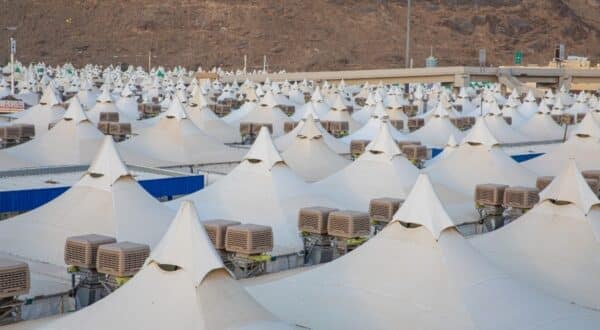
Do All Muslims Know When Hajj Starts and Ends?
The rituals of Hajj begin on the eighth day of Dhu al-Hijjah and continue until the thirteenth day of the same month. Hajj includes various activities and rituals performed by the pilgrims.
Hajj begins with the Day of Arafat on the ninth of Dhu al-Hijjah, which is the greatest pillar of Hajj. Pilgrims travel from Mecca to Arafat and stand there until sunset in what is known as the Standing at Arafat. This is one of the most important rituals of Hajj, providing pilgrims the opportunity to seek forgiveness and pray for themselves and others.
Afterward, pilgrims proceed to Muzdalifah to spend the night and collect pebbles for the ritual stoning of the devil in the following days. On the tenth day, pilgrims go to Mina to perform the stoning of the three pillars known as Jamarat. They also slaughter their sacrificial animals if required, shave or trim their hair, and then head to the Kaaba to perform the Tawaf al-Ifadah and the Sa’i between Safa and Marwah.
Hajj continues for several days, until the thirteenth of Dhu al-Hijjah. During these days, pilgrims perform various rituals such as stoning the Jamarat and exiting the state of ihram. If a pilgrim cannot stay until the thirteenth, they may exit ihram and leave Mecca earlier.
It is not only important for a Muslim to know when Hajj starts and ends, but also to understand the significance of Hajj. The goal of Hajj is to unite Muslims from around the world, strengthen their faith and piety, teach patience, cooperation, and sacrifice, and remind them of the importance of continuous good deeds and striving in the way of Allah.
Hajj is one of the most significant Islamic rituals, gathering Muslims from diverse backgrounds in worship, remembrance, and supplication. Pilgrims practice patience, humility, forgiveness, and sincerity in their work and obedience to Allah. This is why Muslims frequently ask when Hajj begins and ends.
Hajj is a multifaceted experience for pilgrims. Knowing when Hajj starts and ends is crucial as it teaches pilgrims patience, endurance, sacrifice, humility, sincerity, and forgiveness. Pilgrims return from Hajj filled with energy, satisfaction, and faith, eager to apply what they have learned in their daily lives.
Muslims worldwide aspire to perform Hajj, expressing their solidarity and unity with other Muslims, praying and supplicating to Allah, and striving to spread goodness, love, forgiveness, and peace throughout the world.
What Time Do the Hajj Rituals Begin? And When Is Hajj Each Year?
In reality, the date of Hajj varies each year according to the Gregorian calendar because the timing of Hajj is determined by the Islamic lunar calendar. Hajj takes place in the month of Dhu al-Hijjah, the twelfth and last month of the Islamic year.
For example, this year (2024 CE / 1445 AH), Hajj and its rituals will occur between July 18 and 23 according to the Gregorian calendar, which corresponds to the eighth of Dhu al-Hijjah (as the Islamic day begins after sunset).
The End of Hajj Rituals
Hajj continues for several days, involving various activities and rituals that pilgrims perform, such as the stoning of the Jamarat and exiting the state of ihram. If a pilgrim cannot stay until the thirteenth day, they may exit ihram and leave Mecca earlier.
The purpose of Hajj is to unify Muslims from all over the world, bringing them closer together, enhancing faith and piety, teaching patience, cooperation, and sacrifice, and reminding them of the importance of continuing good deeds and striving in the way of Allah.
When Does Hajj 2024 End?
The Hajj season for 2024 is expected to end on the evening of Wednesday, June 19, 2024, after the completion of the Days of Tashreeq. These dates are approximate based on the Islamic lunar calendar, so the question of when Hajj begins and ends might not have a precise answer, as the exact dates depend on the moon sighting by the religious authorities in Saudi Arabia.
The Six Days of Hajj Rituals
When we ask, “When does Hajj begin and end?” we remember the verse from the Quran: “Hajj is in well-known months.” (Al-Baqarah: 197). Allah mentioned the months of Hajj in this verse, implying that the time for performing Hajj rituals is within these months.
This spiritual journey has two types of timings:
1. Zonal Timing mentioned in the previous verse.
2. Locational Timing explained by the Prophet’s tradition, which must be adhered to once a pilgrim enters the state of ihram.
However, the Hajj rituals do not occupy all the months of Hajj except for those who enter ihram at the beginning or delay some rituals to the end. The six days in which Hajj rituals are performed are as follows:
First: The Eighth Day of Dhu al-Hijjah
Known as the Day of Tarwiyah, on this morning, pilgrims enter the state of ihram if they haven’t done so before. They then proceed to Mina after sunrise and stay there until the following day (the Day of Arafat).
Second: The Ninth Day of Dhu al-Hijjah
This is the Day of Arafat, followed by the night spent in Muzdalifah. After sunrise, pilgrims move from Mina to Arafat to perform the most significant Hajj ritual, standing at Arafat, until sunset. They pray Zuhr and Asr combined there. After sunset, they head to Muzdalifah, continuing to recite the Talbiyah, a significant part of the rituals. In Muzdalifah, they pray Maghrib and Isha combined, collect pebbles for the stoning ritual, and stay there until the dawn of the next day.
Understanding the significance and timing of Hajj rituals helps Muslims prepare for this important act of worship, ensuring they fulfill one of the pillars of Islam with devotion and precision.
Third: The Tenth Day of Dhu al-Hijjah:
This is the day of Eid al-Adha, or the Day of Sacrifice. Before sunrise on Eid al-Adha, pilgrims head towards Mina. Upon arrival, they have several duties to perform:
1. First Duty: Stoning Jamrat al-Aqabah (the large pillar):
It is recommended to perform the stoning immediately upon arrival in Mina.
2. Second Duty: Sacrificing an Animal:
Pilgrims then proceed to the place designated for sacrifice to perform the ritual slaughter. This is obligatory for those performing Hajj al-Tamattu’ and Hajj al-Qiran, but it is recommended for those performing Hajj al-Ifrad.
3. Third Duty: Shaving or Trimming the Hair:
Pilgrims should then shave their heads or cut a portion of their hair, which marks the first stage of exiting the state of ihram, lifting all restrictions except for marital relations.
4. Fourth Duty: Tawaf al-Ifadah (Tawaf of Visit):
After shaving or trimming, pilgrims travel to Mecca to perform Tawaf al-Ifadah, circling the Kaaba seven times. This is a crucial part of Hajj, followed by the Sa’i between Safa and Marwah if it hasn’t been done earlier.
Fourth and Fifth: The Eleventh and Twelfth Days of Dhu al-Hijjah:
These are the first and second days of Tashreeq, also the second and third days of Eid. After performing Tawaf al-Ifadah on Eid, pilgrims return to Mina to complete the following duties:
1. First Duty: Spending the Night in Mina:
Pilgrims spend the nights of these two days in Mina. This is considered a Sunnah by the Hanafis and obligatory by others.
2. Second Duty: Stoning the Three Jamarat:
Pilgrims must stone all three pillars (Jamarat) on both days. The stoning begins after the sun has passed its zenith. They start with the small Jamarah (first), followed by the middle Jamarah (second), and finally the large Jamarah (Jamrat al-Aqabah or third).
3. Third Duty: First Departure (Nafrah al-Awwal):
After stoning the pillars on the second day of Tashreeq (the third day of Eid), pilgrims may leave Mina for Mecca, exempting them from stoning on the third day if they leave Mina before sunset according to the Shafi’is or before dawn according to the Hanafis.
4. Fourth Duty: Al-Muhassab (a valley near Mecca):
If pilgrims make the first departure to Mecca, they may stop at the valley of Al-Muhassab, which is located between two mountains near the cemetery known as Al-Hajun, and pray the Dhuhr, Asr, Maghrib, and Isha prayers.
Sixth: The Thirteenth Day:
This is the third day of Tashreeq (or the fourth day of Eid) and is known as the second departure (Nafrah al-Thani). It includes two duties:
1. First Duty: Stoning:
If pilgrims did not leave Mina the previous day, they must stone the three Jamarat as done on previous days.
2. Second Duty: Second Departure:
After stoning, all pilgrims depart Mina for Mecca, marking the end of the Mina rituals. Staying in Mina beyond this day is not prescribed.
If a pilgrim performs Hajj al-Ifrad (without performing Umrah), they may perform Umrah. Umrah is permissible throughout the year except on the Day of Arafah and the four days following it, during which it is disliked. To perform Umrah, pilgrims travel to the boundary of the Haram, the closest point being Al-Tan’eem (known as Masjid Aisha). After entering ihram, pilgrims perform Tawaf around the Kaaba, Sa’i between Safa and Marwah, and then shave or trim their hair, exiting the state of ihram.
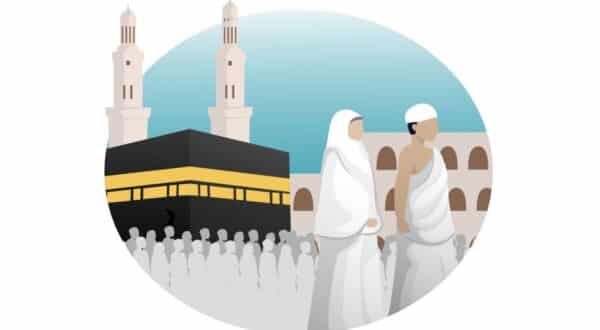
The Final Ritual of Hajj: Farewell Tawaf (Tawaf al-Wada’)
When a pilgrim intends to leave Mecca, they must perform the Farewell Tawaf, circumambulating the Kaaba without hastening or performing Sa’i (the walk between Safa and Marwah). This Farewell Tawaf is obligatory and should be done after Tawaf al-Ifadah. However, if a woman is menstruating or in postnatal bleeding, she is exempt from this Tawaf.
The Time and Place of Hajj
When discussing the timing and duration of Hajj, it is essential to understand that Allah has designated specific times and locations for performing Hajj. The timing is during the months of Hajj, as mentioned in the Quran: “Hajj is [during] well-known months” (Al-Baqarah: 197). The place is the sacred city of Mecca, as stated: “Allah made the Kaaba, the Sacred House, a means of support for the people” (Al-Ma’idah: 97). There are also specific locations designated for assuming the state of Ihram for those intending to perform Hajj or Umrah.
The Temporal Boundaries of Hajj
The temporal boundaries of Hajj span three months: Shawwal, Dhu al-Qi’dah, and Dhu al-Hijjah, with some scholars specifying up to the 10th of Dhu al-Hijjah based on the Quranic verse. These months mark the period within which Hajj rituals must be completed.
The Spatial Boundaries of Hajj
The spatial boundaries for Hajj are established through the hadith of the Prophet Muhammad (peace be upon him), which designates specific locations (Mawaqeet) for assuming Ihram based on the pilgrim’s region of origin:
- For the people of Madinah: The Miqat is Dhul-Hulayfah (Abyar Ali), located about 400 kilometers from Mecca.
- For the people of the Levant, Egypt, Sudan, and Africa: The Miqat is Al-Juhfah, a village that was ravaged by a flood and subsequently became uninhabitable. Pilgrims now assume Ihram from Rabigh, which is about 183 kilometers from Mecca.
- For the people of Yemen: The Miqat is Yalamlam, currently known as Al-Sa’diyyah, approximately 120 kilometers from Mecca.
- For the people of Iraq and the East: The Miqat is Dhat Irq, which lies near a small mountain and is about 100 kilometers from Mecca.
- For the people of Najd: The Miqat is Qarn al-Manazil (today known as Al-Sayl), located about 75 kilometers from Mecca, near Ta’if.
For those residing within these designated areas, their Miqat is their place of residence.
Reflection on the Significance of Hajj
Understanding when Hajj begins and ends, one realizes that millions of Muslims from around the world aspire to perform Hajj. It symbolizes solidarity and unity among Muslims, an opportunity to turn to Allah in supplication, and a commitment to spreading goodness, love, tolerance, and peace throughout the world.


